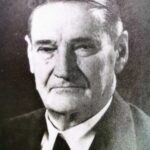OSEI, YAW AKOTO
- 5 Min Read
Osei Yaw Akoto (Circa 1800-1833) was Asantehene from 1824-1833. Although not usually numbered among the great Asante rulers, he decisively affected the course of the nation’s history, first by demonstrating the priority of central government over regional interests, and second by his recognition, in the Treaty of 1831, that the stimulation of trade could be more important than the maintenance of territory.
He was the youngest surviving son of the Asante Queenmother Kwaadu (or Konadu) Yaadom, by her marriage to Owusu Yaw of Anowo, Kumase. Upon the death of his older brother, the Asantehene Osei Bonsu [ruled 1800-1824], the claims of a number of candidates for office were advanced. With the support of the war party, however, Osei Yaw Akoto seized the Golden Stool without regard for due constitutional procedures and marched immediately to the south where an Asante army lay ready to take the field against the British on the Gold Coast. On January 21, 1824, at Nsamankow, advance units of the Asante army had already fought and defeated a British expeditionary force led by Governor Sir Charles Macarthy, who was slain. Osei Yaw Akoto joined the troops in March, and was acclaimed Asantehene.
Throughout May, June and July 1824, Osei Yaw Akoto’s troops blockaded British headquarters at Cape Coast in a massive demonstration of Asante power. In August however, the forces were slowly withdrawn, smallpox having broken out in the camps. Osei Yaw Akoto’s hope that the British would henceforth respect Asante sovereignty over the Gold Coast proved false. The British continued to incite the rulers of the southern provinces to rebellion against the Golden Stool. In 1826 Asante armies again took the field, Osei Yaw Akoto accompanying in person the main forces, which took up positions behind Accra. On August 7, 1826 a major battle was fought at Katamanso (Akan-tamasu), near Dodowa, and the Asante forces were defeated and forced to retire.
Back in Kumase, Osei Yaw Akoto found himself under some pressure to abdicate, but continued to enjoy sufficient support to retain control of affairs. A number of his opponents were executed. Nevertheless, he was obliged to recognise the strength of the opposition to any further attempt to resolve the southern problem by military means. An uneasy peace prevailed. Throughout 1827 and 1828, attempts to obtain a formal treaty reconciling Asante and British interests on the Gold Coast failed. The deadlock was broken in 1830 after the arrival of George Maclean on the Gold Coast as president of the newly-created Council of Merchants. Maclean immediately resumed negotiations with Osei Yaw Akoto, and on April 27, 1831 a Treaty of Peace and Free commerce was signed. By its terms, the Asante government transferred to the British the administration of many of the southern provinces, in return for guarantees of free access to the coastal ports for trade. Although the treaty represented a diminution of Asante political authority in the south, its acceptance by Osei Yaw Akoto was in many respects an act of far-seeing statesmanship. The treaty was to relieve Asante of the burden of high military expenditure in the south while permitting the great expansion of its external trade. It proved an eminently satisfactory basis for cooperation between the Asante and the British administration for the next 20 years.
Although it is Osei Yaw Akoto’s relations with the British on the Gold Coast which invariably dominate any evaluation of his reign, there are indications that he also pursued innovatory northern policies designed further to develop Asante’s links with the powers of the western Sudan. Evidence is extant of Asante diplomatic and commercial intercourse in the 1820s with Ahmadu Labbo of the Dina of Massina and Da Kaba of the Bambara Kingdom of Segu (both in present-day Mali) and with the Maninka-Mori probably of Kankan (in present-day Guinea). It may be that Osei Yaw Akoto saw in the development of such links a possible counterbalance to a too-exclusive involvement in the affairs of the disturbed south.
Osei Yaw Akoto’s reign was clearly dominated by the concern with foreign affairs. On one important constitutional issue, however, he showed himself fully committed to the centralising policies of his predecessors. Rejecting the claims of the Dwabenhene (ruler of Dwaben, 15 mi [24 km] northeast of Kumase), Boaten Panin, to virtual equality of rank with the Asantehene. Osei Yaw Akoto deprived Dwaben of its jurisdiction over a number of the northeastern provinces. When revolts against this new arrangement broke out, he dispatched forces under Anantahene (head of the Asantehene’s palace guard) Enuben Akyaw to the provinces, and, in a series of campaigns starting in 1829, all opposition was crushed. In an unprecedented surprise move, Osei Yaw Akoto ordered his troops into action against Dwaben itself. The town was occupied, and Boaten Panin and his adherents were obliged to flee southwards into British protected territory.
Osei Yaw Akoto died from natural causes in 1833.
IVOR WILKS




